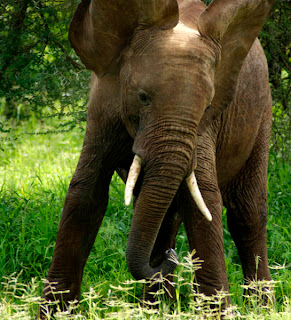 |
| Kimberly Blasnik uses a solar powered satellite device to upload all of our blogs throughout the trip. Photo Credit: Jon Cox |
 |
| Matthew Grasso snorkels while scanning the reef for a variety of marine species. Photo Credit: Kimberly Blasnik |
 |
| The largest bonfire ever, built to celebrate the finale of our trip! Photo Credit: Christine Edwards |
 |
| Preston Kinkle showing off his trendy tire shoes. Photo Credit: Kimberly Blasnik |
We stayed in Arusha at the Pamoja Inn for two nights and had time to finish all of our work. We then visited the Cultural Heritage Center, the largest art gallery in Africa. There was an eye-catching collection of paintings, life-sized wood carvings, traditional masks, and beadwork. From there we went to the Maasai Market, a crowded cluster of open air shops where the owners will try and say anything to persuade you to buy some of their hand-made goods. We were able to practice some of our Swahili and bartering skills and made out with some great deals. Preston even traded his sleeping pad and wallet for a pair of sandals made from recycled tires, they are all the rage in Tanzania! Later that evening we attended a silent auction of photographs of the Hadza by Jon Cox and Daudi and Trude Peterson. All proceeds from the artwork go the Dorobo fund to benefit the Hadza.
The next day we set out on a long and hot bus ride to the coast. It was an exhausting day of travel, but what awaited us at Pembe Abwe beach was worth the hassle. We were met with soft white sand and warm water as we walked along the beach to our huts overlooking the Indian Ocean. We had barely set our bags down and we were headed to the water for a refreshing swim before dinner. Over the next two days we took turns kayaking through mangroves and boated to a sandbar for an afternoon of snorkeling. We saw many exciting marine species including clown fish, an octopus, a sea turtle, and dolphins. We also celebrated the end of our study abroad trip with an epic bon fire on the beach. Tomorrow we begin our long journey home and we can’t wait to see you all!
Don’t forget to order our course book recapping our entire trip! Details coming soon…





























